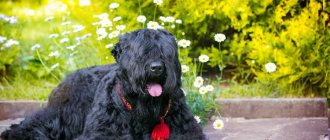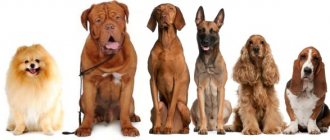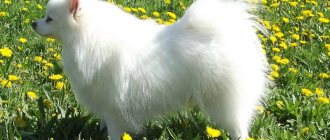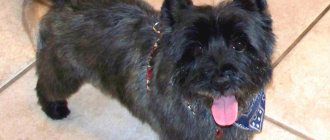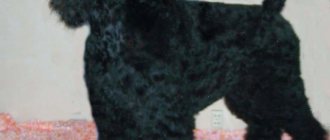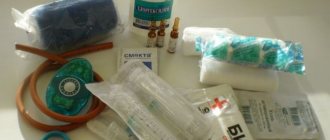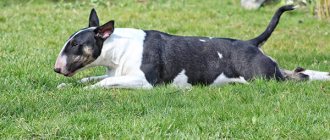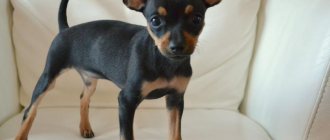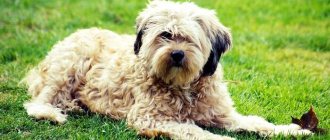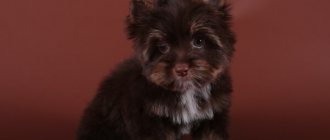Only two blackies are better than one blackie! https://clck.ru/PWWGY
The glory of the Russian black terrier, and for lovers - the blackie, runs ahead of him, surrounded by rumors and speculation.
This furry, serious and good-natured giant has never been called a name for its history, which is not too long for a dog breed! And Stalin's dog, and the KGB dog, and the Black Death.
Few people know that the black terrier is not a terrier at all. The International Cynological Association, which for a long time - almost thirty years - has been promoting the breed with recognition, classifies the blackie in the class "Pinchers and Schnauzers" (I wrote about the classification itself here
).
In fact, a much larger number of breeds took part in the development of this beautiful breed, the pride of Russian cynology.
Okay, Mommy, I’ll agree to a schnauzer somehow. But the pinscher is definitely not my thing. https://clck.ru/PWWkL
Just imagine the level of knowledge of the workers of the Krasnaya Zvezda nursery, who in 1949 received the task from Himself to breed a domestic guard breed with the following set of qualities:
frost-resistant - with thick long hair;
physically strong;
with long limbs for fast running;
with wide paws so as not to fall into the snow;
with powerful jaws and teeth;
fierce, but well trained.
Disappointing the top leadership of the country in those days was like death, and the dog handlers took up the cards.
The work began with interbreeding:
East European Shepherd x Newfoundland;
St. Bernard x Caucasian Shepherd;
Great Dane x East European Shepherd;
Newfoundland x Caucasian Shepherd;
Giant Schnauzer x Airedale Terrier;
Giant Schnauzer x Rottweiler.
Already in the 50s, cynologists managed to achieve the emergence of a new breed group, the black terrier. The ancestor of the breed is considered to be the Giant Schnauzer Roy.
Since 1957, black terrier puppies have become available to dog lovers, and began their triumphant march around the world in the 80s, after recognition by the FCI.
And today, the Black Russian Terrier is considered a dog that combines formidable service qualities with external attractiveness, a gentle attitude towards its family, friendliness towards other animals and excellent training abilities.
This is the case when you can have a giant and not be afraid that he will grow up to be a killing machine.
Chernysh is gentle with children too:
And with cats:
I have a special relationship with black terriers: for some reason, many lovers of wheaten terriers used to keep black ones. Typically, RCT lovers love their breed so much that they don’t want anyone else. But still, the black terrier is a big dog. Sometimes you have to choose someone smaller. And yet, our breeds have something in common.
Our friends are the beautiful Philadelphia, aka Filimona, aka Filya. We were allowed to post a photo of Fili and her son Gavrila here. Scroll through the gallery:
Filya starts every morning with stretching. All photos: https://www.instagram.com/levik_sharupich/
Filya starts every morning with stretching. All photos: https://www.instagram.com/levik_sharupich/
Filya starts every morning with stretching. All photos: https://www.instagram.com/levik_sharupich/
Filya starts every morning with stretching. All photos: https://www.instagram.com/levik_sharupich/
Filya starts every morning with stretching. All photos: https://www.instagram.com/levik_sharupich/
Filya starts every morning with stretching. All photos: https://www.instagram.com/levik_sharupich/
The lives of Fili and Gavryusha and their household are always interesting to watch. Here is young Gavrila learning to walk around the perimeter to the sounds of the Hakuna Matata:
To be honest, I fell in love with this breed a long time ago, like many of its owners. How great it is to be friends with such a large and gentle creature, who also has great health (so they say).
Yes, blackies require decent coat care - trimming regularly, wiping the beard after water feeding, and taking care of their paws and ears. But they do not smell and hardly shed.
But, of course, if you want to work with them seriously, everything is different here - it’s just a different way of life. If you like wire cutters, you can see the little blackie in action:
And here are the most striking reviews from blackie owners:
“A strong-willed, thoughtful and decision-making gentle bearded girl”;
“This shaggy black little man is becoming a full-fledged member of the family”;
“Only two Russian black terriers can be better than RCT”;
“One owner’s black terrier loved pancakes so much that he learned to say “mama” in utero for the pancake;
“I envy everyone who has the opportunity to kiss a big black nose with white envy”;
“Children are allowed to count teeth in their mouths, sleep together with the cat, obey half a word, and when he barks, everyone jumps.”
Reviews from the site irecommend.ru
Due to its size and reputation, now the Black Russian Terrier breed is not as in demand as before - people save money. But read the poems of a black breeder.
The first part is about how they call her and ask about the puppies, and then they don’t come. And here is the ending of the poem:
And you know the little black one will spread its paws and purr:
“Stroke my belly, I’ve just eaten enough meat.
In the end my eyes are like coals
I am naturally black.
And you know – I don’t just sell out!
My delicate plush is not for lovers of sackcloth.
...Sit, breeder, waiting for calls,
Counting “profit” with raking hands...
Salary eaten up by advertising of all puppies,
Advance and bonus - by the puppies themselves...
But don't give up! - better bite some bread.
And rest assured that not everything is lost,
There is Royal Canin in the fridge
And the little blacklings fawn, having eaten to their fill!
Poems by Tatyana
from here
Here it is, the breeder’s happiness - one of Fili’s puppies:
UPD: I thought it was interesting to add a new video here: this is what the same puppy Gavryusha looks like now:
Cool breed, in my opinion!
Good dogs to everyone! ?
Black Russian Terrier
- a Russian service dog breed, bred in the second half of the 20th century in the USSR in the Krasnaya Zvezda kennel, by crossing the Giant Schnauzer, Airedale Terrier, Rottweiler, Newfoundland and others. The original breed was the Giant Schnauzer.
The dog is above average height, strong-boned, unpretentious to living conditions, resistant to colds, and lends itself well to various types of training. Currently [ when?
] the black Russian terrier has spread throughout the country[
which one?
] and has established itself as one of the best working breeds. This is an active participant in competitions in almost all service types of training: general training course, protective guard and sentry service, city dog, Russian ring, and so on.
Historical reference
The black terrier was bred at the military dog breeding school near Moscow on the basis of the Krasnaya Zvezda breeding kennel.
The order for it came from I.V. Stalin shortly after the end of the Great Patriotic War - in the harsh climate of the country it was not always possible to use European breeds. The goal of the nursery was to:
- get a large, brave, strong, controllable dog with a pronounced protective instinct;
- a dog suitable for performing various types of services , adapted to different climatic conditions.
Soviet Russia needed its own dog, ready for hard service, and it appeared.
In order to develop a breed fully adapted to harsh and varied conditions, it was necessary to carry out lengthy interbreedings. The Black Terrier was obtained from numerous crossings of dogs of such breeds as the Airedale Terrier, Newfoundland, and Giant Schnauzer.
As a result of painstaking work, by 1981 it was decided that the black terrier breed had been created and it was time to establish it as a standard. The standard was finally adopted in 1983, and in 2010 its new edition appeared.
At the origins of the “black pearl”. War hero A.P. Mazower and the Krasnaya Zvezda nursery
The Central School of Military Dog Breeding, based at the Krasnaya Zvezda kennel, was engaged in breeding not yet a breed, but simply large working dogs, intelligent and hardy. One of the leading experts was the patriarch of Soviet cynology, author of dozens of books, Alexander Pavlovich Mazover. During the war, Lieutenant Colonel “San Palych” (as his students called him) commanded the 37th separate mine clearance battalion. Afterwards, he became the husband of the legendary Dina Volkats, commander of a separate platoon of mine trainers, “trainer” of sapper dogs and saboteurs, and owner of Dzhulbars. The couple worked at Krasnaya Zvezda together with V.P. Sheinin and biologist N.A. Ilyin.
Black terrier puppy./Photo: chrisridogs.co.za
Breeding work was complex and spontaneous: not only many purebred animals were taken into breeding, but also mestizos, often even “improvised material” - dogs with malocclusion or cryptorchidism. In the veins of the first blackies flows the blood of Giant Schnauzers, Airedale Terriers, Rottweilers, Newfoundlands, crosses with Great Danes, hounds, Doberman Pinschers, Moscow Divers (an unsuccessful breed resulting from a Newfoundland and a German Shepherd), Moscow Great Danes (a Great Dane crossed with a German Shepherd), the blood of Moscow watchdogs , random representatives of South Russian Shepherd Dogs, Laikas and Poodles. This entire amazing melting pot led to the appearance, first, of a motley generation of large dogs, convenient for the military, in black color. The ancestor of the breed is considered to be the Giant Schnauzer Roy; his offspring were invariably large, woolly and black.
After checking the working qualities, strict selection began. And at the All-Russian Agricultural Exhibition in 1955, all the dogs received diplomas, and the dog handlers received a gold medal. Subsequently, some of the puppies were handed over to Moscow amateur dog breeders, and then the blackies spread throughout the country. For 26 years, not only the psyche and intellect, distrust and vigilance, but also the exterior were polished: civilian dog handlers preferred longer and more luxuriant fur. In the 80s, terriers saw international exhibitions. Finally, the Black Russian Terrier breed was recognized by the FCI in Mexico City at the 1984 International Assembly.
Today, the Black Russian Terrier is a huge, spectacular and powerful dog. Despite the name, the breed is now classified as a Molosser (Mastiff) rather than a Terrier. The size of the RCT is amazing. Males are taller than a standard desk, females are somewhat smaller. The character of blackies is Nordic. They are calm, self-confident, resilient and efficient.
Adult black terrier./Photo: i.pinimg.com
Description of the breed
FCI Standard No. 327 dated October 13, 2010, Group 2 “Pinchers and Schnauzers – Great Danes and Swiss Mountain Cattle Dogs.” Section 1 “Pinchers and Schnauzers”.
Standard height at withers:
- males - 72-76 cm, but not less than 70 cm and not more than 78 cm.
- females - 68-72 cm, but not less than 66 cm and not more than 74 cm.
Higher growth is allowed provided that the proportions and correct breed type are maintained.
Weight: males – 50-60 kg, females – 45–50 kg.
The standard imposes the following requirements for the exterior:
- The body is massive, proportionally built.
- The chest is wide and deep, the ribs are convex. The withers are well defined. The back is straight, muscular, the loin is short, slightly convex, the croup is long and wide.
- The head is elongated, widened in the area of the brain part of the skull. A mustache and beard are required. The nose is large and dark, the gums are dark.
- The neck is massive, long, and muscular.
- The ears are drooping, but carried high. The standard ear shape is a triangle.
- The eyes are oval and widely set. The eyelids are dry and tight fitting.
- Has 42 teeth. The bite is scissor-shaped, the incisors are located on the same line.
- The tail is docked at the level of the third vertebra.
- The legs are straight and parallel. The shoulder blades are long and set at right angles. The shoulders are parallel and vertical.
- The paws are rounded, the claws are dark.
- The coat is coarse with a soft undercoat. There is decorative hair that forms the beard and mustache.
- The only color allowed is black with a little graying.
Dogs of this breed are good runners, making long jumps.
The usual gait is trot and gallop. When running, the paws are placed straight, the joints extend freely.
Pomeranian Spitz
The Pomeranian is descended from Arctic dogs with thick, Spitz-like coats. But breeders wanted a smaller version of these large sled dogs.
Pomerania, an area that now includes parts of Poland and Western Germany, is the breed's namesake and the place where these dogs were first bred. These small dogs are generally smart and curious. They can learn tricks easily and love to perform them to attract the attention of their loved ones.
Character, abilities, skills
The breed was bred specifically for guard duty. The task of the black terrier is to protect the territory and objects located on it from the penetration of a stranger. Such dogs “keep the circle”, that is, they do not allow people to cross a certain line.
These properties make it possible to use black terriers as bodyguards. A properly trained dog will guard its owners and their children with restraint, but strictly.
At a young age, these dogs have a cheerful and lively disposition. At the same time , they are famous for their fearlessness, independence and confidence.
At a more mature age, black terriers become sedate, which does not affect their working qualities.
Until old age they will be faithful watchmen and bodyguards.
Puppies of all large breeds mature late. The black terrier is no exception. Puppies should be obedience trained until they are one year old. After a year, you can begin guard training. With proper training, a good service dog will be ready by the age of two.
Only this smart and even intelligent dog cannot be kept on a chain. However, such captivity is harmful to any dog. Chain dogs are always people with a damaged psyche.
Catahoula Leopard Dog
- Height: from 51 to 66 cm
- Weight: from 23 to 43 kg
- Life expectancy: 10 to 14 years
This is the only purebred dog breed that originated in Louisiana. The name “Catahoula” was given to it by the Choctaw people; from Indian it is translated as “sacred lake” . Available in an incredible variety of coat colors, the Catahoula Leopard Dog is almost always adorned with unusual markings throughout its body, similar to those of a leopard print. What also adds to her charm are her magnificent blue eyes, which their owners describe as human and very friendly.
These dogs are bred primarily for herding, although they also make good family dogs. They are gentle, affectionate and friendly. Although, like all domestic dogs, this breed requires regular training, socialization, mental stimulation and exercise to be happy, healthy and well-rounded.
Maintenance and care
The black terrier is well adapted to living in a city apartment. Despite the fact that this dog is large and shaggy, there is little dirt or inconvenience from it.
The fact is that with proper care of a dog's fur coat, the dirtiness of the apartment can be minimized. To do this, you will have to constantly comb out the thick undercoat.
It is necessary to bathe a dog only if it lives in the same house as a person. This should be done as needed, but not more than once a month.
Frequent bathing demoralizes the dog, because it loses its natural scent.
Large breed dogs rarely eat as adults. Usually once a day is enough. The healthiest diet consists of a combination of porridges from various grains with meat and sea fish.
The biggest problem in this case is that dogs need to be periodically fed raw and even slightly rotten meat. After all, by their nature they are not so much predators as scavengers. In this case, there is a danger of infection with helminths.
Australian Cattle Dog
- Height: from 43 to 51 cm
- Weight: from 14 to 20 kg
- Life expectancy: 13 to 15 years
The Australian Cattle Dog, also known as the Blue Heeler , is considered one of the smartest dogs in the world. This famous herding dog comes from Australia. It comes in red and blue colors, but almost always has spots and patterns on its coat. At the same time, some dogs have coat coloring that resembles the skin of a leopard.
Although Australian Cattle Dogs are quite intelligent , they are usually difficult to keep for first-time dog owners. They require regular mental stimulation and consistent exercise and are best suited for experienced dog owners. They also do well in homes with large, securely fenced yards where they can run and play freely.
Pros and cons, price
The advantage of black terriers is the combination of excellent working qualities of a dedicated guard with patience and tact.
The disadvantages include the need for constant grooming. In addition, with any care, you will find dog hair in any corner of your apartment.
You can buy a black terrier puppy for a price ranging from 25 to 50 thousand rubles. The cost depends on:
- region;
- puppy age;
- pedigree;
- breeder's pricing policy, etc.
The Black Russian Terrier is a wonderful breed, but it is not suitable for all purposes. These black giants cannot be just dogs. They need to work, but work can be replaced by long walks.
Additionally, check out a short video about the Black Russian Terrier breed:
Iberian
There is a second name - mountain dog. From afar, snow-white representatives of this breed can be mistaken for a fluffy polar bear. Sometimes there are individuals with colored splashes. Their coat is long and therefore requires special care.
The character of the animal is soft, like that of any shepherd dog.
She is hardy and courageous, and can be a wonderful guard and companion for humans.
An important condition for keeping a mountain dog is freedom. The adjacent area or enclosure is perfect for this, but in an apartment the dog will quickly wither away.
Black Terrier is Beria's dog. Or Stalin
In 1984, the FCI, the Fédération Cynologique Internationale, officially recognized and registered a new breed, the Black Russian Terrier. In the USSR, as a breed itself, it was registered in 1981. Until this time, it was considered a “breed group”. This breed group “Black Terrier” was first demonstrated to the public at the All-Union Agricultural Exhibition in 1955.
How did this dog appear?
After the Great Patriotic War, it became clear that the losses of service dogs during hostilities were enormous, and the country was sorely lacking in “special” dogs. But there was no universal dog, a “universal soldier” who could perform any type of service, both in wartime and in peacetime. And then at the highest level a decision was made - to create a breed of dogs with the following requirements for it.
Qualities of the future breed
The future dog should have been:
- large
- intellectual
- easy to learn
- unpretentious
- cold-resistant (use in the Far North)
- long-haired but non-shedding (minimal grooming)
- self-possessed, calm (strong nervous system)
- hardy and efficient
- contact and devoted to the person
- angry and distrustful of strangers
- inconspicuous, non-variegated color
How can such a breed be created? The task was not easy, since there are mutually exclusive qualities here. The Krasnaya Zvezda nursery was entrusted with the task of breeding a new breed. Initially, they tried to cross a German shepherd with a husky, but nothing good came of it. It became clear that we would have to tinker, since to solve this problem it would be necessary to use “interbreed (multiple) crossing in different combinations.”
The following dog breeds were involved in the development of the new breed: Airedale Terrier, Rottweiler, Poodle, Laika, German Shepherd, Caucasian Shepherd, South Russian Shepherd, Newfoundland, Giant Schnauzer, Great Dane, Hound and Doberman. But, in the end, the fundamental breeds were: Airedale Terrier, Rottweiler and Giant Schnauzer
.
As a result of this crossbreeding, the pride of our selection appeared - “Black Pearl” or “Blackie”. The ancestor of the breed was recognized as a Giant Schnauzer named Roy - he produced large, woolly and black puppies with enviable consistency.
From the beginning of the 50s, the breed was polished and honed right up to 1984, when it was officially recognized at the International Assembly in Mexico City.
What happened in the end?
Qualities of the Black Russian Terrier
Nowadays, you can rarely meet a Black Russian Terrier on the street. But in vain. The dog is truly unique. So what makes it unique?
The result is a dog that combines incompatible qualities. Firstly
, the discrepancy between the name of the breed and the blood of the dog itself - the dog is called a terrier, but in fact, it’s not even a terrier at all! The breed belongs, according to all classifications, to mastiffs (Molossians).
Well, and secondly
, and this is the most important thing - a SUCCESSFUL combination of everything conceived by the developers of this breed: size (a male can be taller than a standard desk and can reach the windowsill), viciousness, amazing endurance and health of the dog, that is, its service and guard qualities (can knock down with one push a strong man), with complete peacefulness and playfulness.
These are not the moronic and thick-headed breeds of bull terriers, pit bulls, Staffordshire terriers and the like, these killers of all living things, and even small children. This is a guardian and a good friend rolled into one.
Do you know that, having absolutely recognized this breed, the entire West with its therapeutic associations uses it for its medical purposes: to help patients with cerebral palsy, ADHD, for recovery after a stroke, for the socialization of people (including children) with autism. This is both a security guard and a canis therapist in one bottle.
But don't try to make him a watchdog. Do not put him on a chain in your country cottage. He needs movement, space and your love. And his devotion won’t matter.
After all, Chernysh, when attacking, not only grabs, but bites hard. There is a huge difference between these terms. Just grabbing is one thing, but biting involves penetration, rotation, and tearing. At the moment of attack, this dog is aimed at the legs, groin, and stomach. It’s not for nothing that this dog is also called “Black Death”.
Links
- NKP Russian Black Terrier
- Electronic catalog of Russian black terriers
- Black Russian Terrier, FCI-Standard N° 327
Coat color is far from the most important factor when choosing a dog. But just as it is human nature to be drawn to beauty, breeders try to create visually attractive pets. To be fair, each color has its own special charm and craving for a certain “color” is a matter of taste. For me personally, there is nothing more beautiful than molded muscles under the shimmer of a black fur coat, like a raven wing.
The guy on the cover is the result of the activities of a foreign nursery. I will attach the address of the official Instagram so that you can look at other dogs of this breeding. The creators position the pets as “XXL pit bulls.” In my opinion, he is a very impressive dog and the color looks excellent. Well, now let's look at breeds with a longer history.
instagram - xxldesignerpitbulls
Black Russian Terrier
In pursuit of a “fashionable” appearance, some breeders forget that impressive “packaging” is not enough to breed a truly delightful dog. The Russian Black Terrier does not have any “X” in its name and five zeros in the price tag, however, in my opinion, this breed is the property of Russia. In addition to the “heroic” build, the dogs named after the well-known leader retain working qualities.
RCT is the result of “improving” the Giant Schnauzer. Roughly speaking. In fact, everything was somewhat more complicated. Rottweilers, Airedales and Newfoundlands also participated in the creation of dogs for the state special order. The result was an “all-terrain vehicle” capable of serving both in the harsh conditions of Transbaikalia and in the humid climate of the Krasnodar Territory. A real Russian “bear” has long limbs for fast running, a windproof fur coat, strong jaws and an endless supply of devotion to people. Another reminder that in the USSR everything was done “conscientiously.”
Wikipedia
Groenendael
In addition to the Malinois, which I sincerely adore, Belgium has another shepherd dog in stock - “Groenendael” (listen, the Belgians know a lot about sonorous names). These are quite serious pets, which are often used as service animals. Despite the average weight of 30 kg. and a height of 55-60 cm, Groenendael's movements are full of grace. Belgian "blackies" are active and have a good disposition. Their trainability is excellent; for this breed there is only one impossible mission - the absence of missions. An “unemployed” Belgian very quickly turns into a woolen tornado, sweeping away everything in its path.
They are not very popular here; to be honest, I have never had the opportunity to meet Groenendael on Russian streets.
Pixabay
Newfoundland
The furry giant has no hunting instinct, so Newfoundland is an example of canine kindness. The giant is not prone to aggression; on the contrary, he is always ready to help people or other animals. “Growing into” the family, the dog endures human rudeness, indifference and betrayal extremely painfully. Owners note that Newfies are capable of the deepest emotional attachment, not characteristic of any other breed.
A distinctive feature of Newfoundland is the webbing between its toes. The rescue diver loves the water very much, so it is imperative to give the dog the opportunity to swim to his heart's content.
Pixabay
Of course, it is impossible to list all the breeds worthy of mention at once. No problem, add your option in the comments.
Thank you for reading us!
“The most loving creature in the world is a wet dog.”
Ambrose Bierce
Black Terrier.
The Black Terrier is one of the very young dog breeds, officially less than forty years old. The owners believe that if you go out into the streets of a metropolis with a little blackie on a leash, the effect of invisibility will arise: no one will notice the person next to the huge photogenic dog. The legends about these dogs are no less shocking: an evil monster, supposedly bred specifically to guard prisoners, for some reason behaves like a bearskin, a terrifying special forces soldier turns into a gentle nanny.
Photographer Andrey Seliverstov. Varvara, Vasilisa and their black terriers Hobbit and Quadrille, multiple winners of international exhibitions./Photo: cs6.livemaster.ru
Russian Black Terrier
Health
Character
Activity
Tendency to train
Security and guard qualities
Attitude towards children
The Black Russian Terrier breed can justifiably be called unique. These large dogs amazingly combine strength, endurance with friendliness and playfulness.
Content:
Representatives of the breed are unpretentious, easy to train, they adore children and are ready to play with them for days. Owners and admirers of this species claim that the black terrier is a man in the guise of a dog. All because of high intelligence, high mental abilities and emotionality.
Putting a Black Russian Terrier on a chain and leaving it alone is a crime. Such a pet needs to constantly communicate with the owner and the rest of the family. A properly raised, trained dog will become a reliable protector, faithful companion and friend.
Other names: black terrier, RCT, Stalin's dog
How to choose a puppy
If you have decided on a kennel, looked at the puppy’s pedigree and met at least one of its parents, proceed to tests that will help you get some ideas about the character of the future pet. Check your baby's level of contact by sitting him at a distance and beckoning him with your hand. Black Russian Terrier puppies with guard potential will approach a stranger immediately and bark loudly. Kids with the makings of a companion behave more balanced and quiet.
It wouldn't be a bad idea to test the tiny little ones for obedience. Lay the puppy on its side, holding it under the chest, and observe its behavior. The future leader will immediately begin to resist and break free. You can lift your Black Russian Terrier off the ground by holding him by the belly with crossed arms so that he looks into your eyes. The reaction of the future companion and family man to this action will be relatively calm, although a little resistance at the beginning of the procedure is also a good indicator. The dominant will try his best to wriggle out of your hands, simultaneously trying to bite them properly.
Another effective way is to give the puppy a good pat when you first meet him. A child with a stable psyche after such an “execution” will simply shake himself off and move away from you. An unbalanced aggressor, on the contrary, will begin to whine, growl and chew your fingers. And of course, immediately discard overly timid puppies for the simple reason that, like overly angry individuals, they are very difficult to train.
History of the breed
The homeland of the black terrier is the Soviet Union. This breed was created by order of the state government. The Krasnaya Zvezda nursery was assigned to fulfill the order. The government led by Stalin set out specific requirements regarding the characteristics of the new type. RCT must have:
- Long, thick coat - for frost resistance.
- Long, muscular legs - for fast running and wide jumps.
- Wide paws - allowing you to move through the snow without falling through.
- Aggressiveness, fearlessness, powerful jaws, enormous physical strength - for excellent security qualities.
Work on the new breed began in 1949. Breeders crossed many species. The genes of the Giant Schnauzer, Newfoundland, East European Shepherd, Caucasian Shepherd, Great Dane, Rottweiler, St. Bernard, and Airedale Terrier were used.
As a result, several breed lines were formed. According to the requirements of the state order, the Red Star dog handlers chose the most suitable option, where the main ancestor was the Giant Schnauzer. He was joined by the genes of the Newfoundland, Rottweiler and Airedale Terrier.
The result of the work satisfied the government. The Black Russian Terrier met all the stated characteristics.
8 years after the start of work on the breed, its representatives were presented at an exhibition of service dogs in the capital of the USSR in the number of 43 individuals. By the end of the seventies of the twentieth century, there were more than 4,000 purebred RCTs.
The eighties brought the Russian terrier worldwide fame and popularity. These dogs took part in international shows and competed in various sports competitions. They enjoyed success everywhere thanks to their beautiful exterior, mental abilities, and physical characteristics.
In the fall of 1983, the ChRT was officially recognized by the FCI as an independent breed.
In the modern world, the black terrier is mostly kept as a companion, a pet, and a family protector. But besides this, CRT is still used by organizations and services as watchdogs.
Dogo Argentino
- Height: from 60 to 68 cm
- Weight: from 35 to 45 kg
- Life expectancy: 10 to 15 years
You might be surprised to find a Dogo Argentino on our list, especially since many of these dogs spotted are completely white. However, they do have the piebald gene, which can cause spots to appear on their coat from time to time.
For the most part, Dogo Argentinos may only have one spot, usually on the eye. Otherwise, these dogs are predominantly snow-white from nose to tail.
As the name suggests, this breed originates from Argentina, where it was bred to hunt large game. Throughout its history, the Dogo Argentino has had a bad reputation , based mainly on its involvement in bloody fights and ferocious fights with wild animals.
However, the modern Dogo Argentino is a relatively gentle, friendly, patient and affectionate dog that can get along well with a wide variety of owners if it is properly raised, trained and socialized.
Breed standard
The Black Russian Terrier is a large breed of dog. He has a strong, athletic build of a rough type. He has well-developed muscles. Bitches are inferior to males in both height and weight.
The height of adult individuals is 70-78 cm , weight is about 52-60 kg .
On a massive neck rests an equally massive, elongated head. The ears are drooping and triangular.
Dark, oval-shaped eyes, not too large, set wide apart. The eyelids are black, not droopy, dry.
The bridge of the nose is straight, the nose is large with well-opened nostrils. The muzzle is decorated with the lush mustache, beard and eyebrows characteristic of all terriers.
The cheekbones are round. The jaws are powerful. The teeth are large and have a scissor bite.
The physique is powerful and muscular. The back line is straight, the loin is strong. The chest is deep. The ribs are convex.
The tail is thick, saber- or crescent-shaped. Set on high. Cupping is allowed (at the third vertebra).
Legs are straight and parallel. The paws are wide and rounded, which allows the RCT to move freely in the snow. The claws are dark.
The walk is a typical gait, a sweeping trot. Jumps are long, due to the powerful hind limbs.
The coat is thick and hard to the touch. Length is about 6-14 cm. The guard hair is straight, slight waviness is allowed. There is a soft undercoat.
The color is black, with minor inclusions of gray allowed.
Boxer
The modern boxer was developed in Germany in the late 19th century. Boxers are believed to have descended directly from the larger, more muscular and now extinct Bullenbeisser ("biting bull") dog breed.
The versatile Boxer dog gained great popularity throughout Germany and was used for herding, security and law enforcement.
Boxers are fun-loving dogs that need a lot of exercise. They are usually very affectionate with their families.
Maintenance and care
Keeping a black terrier on a chain or in an enclosure is not recommended. This is a very sociable dog and needs to be around family members. If it is not possible to place an RCT in the house, install a fence around the perimeter of the yard, install a warm, large booth and ensure frequent contact with the pet.
It is unacceptable to leave him alone for a long time, as the terrier can eventually become aggressive, angry and irritable.
Keeping a Russian Terrier in an apartment has its own difficulties. This dog does not bark often, but he snores loudly in his sleep. Representatives of the breed are also not known for their neatness. After eating, food residue remains on the beard and mustache.
You need to immediately wipe the dog’s face with a towel; if he manages to shake himself off a couple of times, then you have to wipe the walls too. Such inconveniences are completely compensated by the terrier’s devotion.
Daily walks are vital for RCT. Two walks per day are recommended, each lasting at least an hour. Please keep in mind that Stalin’s dog requires active training, training for at least half an hour a day.
In general, caring for a Black Russian Terrier is not very difficult. Luxurious wool takes the most time. The main thing is to carry out all the procedures outlined below on time and in good faith:
- We comb the fur 2-3 times a week.
- A trimmer is required, the first procedure is carried out when the puppy is 6 months old.
- Grooming. The haircut should emphasize the strength and power of the Russian Terrier. Excessive decorativeness is not encouraged. The longest hair is usually left on the legs and face.
- Terriers do not like bathing too much, but this procedure is necessary. We bathe our pet about once a month, without overusing detergents. After each walk, wipe the coat with a damp towel and wash the paws.
- Brushing teeth twice a week. You will need a special paste. It is also important that the terrier's diet includes solid food or bones from natural veins in the form of treats. These treats prevent the formation of tartar.
- We trim the claws with a nail clipper designed for large breeds as they grow. This procedure is carried out approximately six times a year.
- We regularly trim the fur between the toes. After each walk, we inspect the paw pads for injuries or splinters.
- We examine the eyes and ears regularly. We carefully clean the ears once a week using special products.
Basic moments
- Black Russian Terriers can be classified as slow maturing dogs, reaching full physical maturity only at 2.5 years of age.
- Despite the fact that representatives of this breed are not decorative pets, you will still have to pay attention to the animal’s fur. Particular attention will be required to long hair on the dog's face, which gets wet and dirty when the animal drinks or eats.
- Adult RCTs are physically strong and resilient individuals who need to work hard to stay in shape. Get ready for long walks, jogging, agility and other joys of working breeds.
- Despite the presence of the word “terrier” in the name of the breed, blackies are included in the group of pinschers and schnauzers.
- Like all dogs whose main purpose was service and security work, Black Russian Terriers are distinguished by a strong character, which must be managed by a serious and authoritative owner. At the same time, they are quite accommodating and very friendly towards children, if they do not abuse their loyalty and trust.
- Having a fairly thick coat with abundant undercoat, RCTs are adapted to low temperatures and spend the winter quietly in insulated kennels and enclosures (does not apply to puppies).
- With the development of the breed, the character of the animals underwent significant changes. Today's black terriers are no longer guard dogs, but serious companions with a minimal level of aggression towards strangers. Moreover, if necessary, they are still able to stand up for both themselves and their owner.
- The Black Russian Terrier can be trained to be a highly qualified watchman, whom even the most experienced burglar will not be able to outwit.
The Black Russian Terrier is a legend and pride of Soviet cynology; a serious intellectual with a developed protective instinct and a self-possessed character, always striving to please his owner. In the philistine environment, RCTs are often labeled as ferocious and uncontrollable bodyguards, ready to tear to shreds anyone who looks askance at their owner. In fact, the aggressive image that once attached to the breed is greatly exaggerated. Those who have completed a training course and are properly socialized are prudent, understanding and extremely adequate pets who will never allow themselves to go into a rage just like that.
Health
Fulfilling the state order to create the Black Russian Terrier breed, dog breeders had to get a dog that was not predisposed to most diseases. The task was completed, RCT very rarely gets sick, easily tolerates significant temperature changes, and is not susceptible to diseases. He is not afraid of colds and various types of viruses.
Stalin's dog is in good health and has a strong immune defense. Representatives of the breed live on average up to 10-15 years.
A common problem for all terriers is a fungus that affects the mustache and beard. In addition, it is worth noting several other health problems that are sometimes observed in RCT:
- Joint dysplasia – the dog feels severe pain, cannot move freely, and limps. With severe neglect of the disease, complete immobility is possible.
- Juvenile laryngeal paralysis is caused by a mutation inherited in an autosomal recessive manner.
- Hyperuricosuria is the accumulation of uric acid salts and the formation of stones.
- Otitis - can affect one or both ears at once; inflammation causes purulent discharge, redness and an unpleasant odor from the ears.
- Entropion, ectropion cannot be treated; surgery is required to eliminate it.
German shorthaired pointer (shorthaired pointer)
The German Shorthaired Pointer came onto the scene in the 1800s. German hunters have long crossed different dog breeds to create a quality hunting dog that is athletic, friendly and eager to please. These dogs are excellent trackers and reliable retrievers. And they tend to be very loving and playful with their families, although they do need a lot of exercise.
Character
The Black Russian Terrier is confident in its abilities in any situation, it is full of dignity, behaves appropriately and calmly. If the situation requires it, when danger or threat arises, the RCT instantly turns into a strict protector, a security guard. He takes an active defensive position, fearlessly ready to repel the attack of any enemy.
The Russian Terrier is intelligent and friendly. He is endlessly devoted to his owner and all family members. Only next to a person is such a dog able to fully develop, both mentally and physically.
Loneliness is unbearable for a terrier. It is impossible to leave such a pet without attention for a long time. A devoted dog can follow its owner all day long, simply enjoying his company.
For children, the black terrier is a faithful friend and play partner. Females show special maternal care to their babies; under such protection the child is safe. Parents must ensure that the dog does not accidentally harm the children with its large dimensions while playing.
Interestingly, representatives of the breed always strive to be closer to the child. If possible, the terrier will even sleep in the children's room, protecting the babies' sleep.
He gets along well with other pets and does not start fights. Conflicts can arise between male dogs.
He treats strangers and house guests coldly, with distrust and hidden aggression. If he notices a threat from them, aggression will immediately manifest itself. The CRT acts instantly, calmly, without warning, and often makes decisions independently. Barks rarely, only in extreme situations.
The Black Russian Terrier requires serious education and training. Without this, he can become an uncontrollable, aggressive and dangerous animal.
Behavior and temperament
A dog with great dignity, self-confident, well controlled in any situation. If necessary, he immediately takes an active defensive position, but quickly calms down when the danger disappears. RCT is handsome and charming, hardy, unpretentious, smart and friendly. Easily adapts to different climatic conditions, is well trained, efficient, and reliable[2].
The Black Terrier is highly trainable. But it should be borne in mind that this dog is not for sitting on the chain of a private cottage. The black terrier, first of all, requires constant communication with the owner, the family in which he lives.
Training and education
The black terrier is smart and quick-witted, he has an excellent memory. That is why training such a dog is not difficult, nor is it difficult to control its actions.
The stubbornness and independent disposition of the ChRT interfere with ideal training. The leadership abilities and strong-willed character of the owner will help to cope with this. He must establish contact with the pet, establish a trusting relationship and show that he is the undisputed leader, the “leader”.
If you do not have experience raising large guard dogs, it is recommended to contact a dog trainer. Under his leadership it will be possible to raise an adequate, controllable guard terrier.
Aggression should not be developed in representatives of the breed. These are already aggressive dogs, it is important to keep them under control.
Lessons should be interesting, varied, and at some points, conduct them in a playful way.
Interesting Facts
- The Black Russian Terrier was bred on the orders of Joseph Stalin himself.
- RCT combines the best qualities of more than 15 different types of dogs.
- The Russian postage stamp (2015) shows a black terrier.
- RCT is suitable for use as a security guard in extremely cold climatic zones of Russia.
- The reaction of the black terrier is so lightning fast that it surpasses even the reaction of a cat.
- RCT is the ideal traveler's companion. This dog adapts perfectly to any climate, quickly adapting to new conditions.
- The terrier usually thinks about the execution of a new command, and then carries it out.
Dachshund
<
Dachshund is translated from German as “badger dog.” These short, merry creatures were bred about 600 years ago to hunt badgers and dig them out of their burrows.
This wiry-coated breed was created to provide additional protection in thorny bushes and cold climates.
These little dogs still have a strong hunting instinct and love to dig.
They can be quite energetic, but are friendly and playful with their families.
Pros and cons of the breed
The modern Russian Terrier is still used as a guard dog and watchman. Only the majority of representatives of the breed perform their duties in families, and not at military or government facilities.
The Black Terrier is a serious, strong dog with a fairly high level of aggression. If you are not sure that you can raise her properly and provide her with the required living conditions, do not rush to buy a puppy. First, familiarize yourself with the main advantages and disadvantages of the breed, then make a decision.
Advantages:
1. Beautiful exterior. 2. Endurance, strength. 3. Devotion. 4. Excellent guard qualities. 5. Gets along great with children. 6. Tolerates both cold and heat normally. 7. Good health.
Flaws:
1. Stubbornness, willfulness. 2. Requires a lot of attention and cannot stand loneliness. 3. High level of aggression, requires strict control. 4. Daily physical and mental activity is needed.
Bully Kutta (Pakistan Mastiff) - description, features of the breed
TOP 30 most dangerous dog breeds
Related Articles
American Bandog - description and characteristics of the breed
Russian Black Terrier 9 Grooming 7.0/10 Health 10.0/10 Temper 8.0/10 Activity 9.0/10 Tendency to train 9.0/10 Security and watchdog qualities 10.0/10 Attitude towards children 10.0/10 Extremely active, massive, intimidating, merciless in rage and while [...]
Drathaar - description and characteristics of the breed
Russian Black Terrier 9 Grooming 7.0/10 Health 10.0/10 Temper 8.0/10 Activity 9.0/10 Tendency to train 9.0/10 Security and watchdog qualities 10.0/10 Attitude towards children 10.0/10 The Drathaar is the embodiment of European hunters’ idea of a universal dog. His […]
Literature
- Vorobyova O.
Black Terrier // Friend: magazine. - 1996. - No. 5 (38). — P. 4-9. — ISSN 0868-6246. - Mishchikha O.
Black Russian Terrier // Friend: magazine. - 2004. - No. 1. - P. 6-14. - Mishchikha O.
Relatives of the Airedale Terrier // Friend: magazine. - 2009. - No. 12. - P. 37. - ISSN 1609-0527. - Gerasimova M.V.
Russian black terrier. - M.: AST, 2010. - ISBN 978-5-904880-40-8. - Yerusalimsky E. L.
Russian black terrier. Legends and reality // My friend the dog: magazine. - M.: Animal Press, 2012. - No. 1. - P. 47-50. - Falcon A.
Black Russian Terrier // My friend the dog: magazine. - M.: Animal Press, 2012. - No. 6. - P. 30.
German guard dogs
Watchdogs are excellent at protecting a home, office or business. They are smart and incorruptible. These include:
- Doberman.
- German Shepherd.
- Leonberger.
- German dog.
- Giant Schnauzer.
- Rottweiler.


